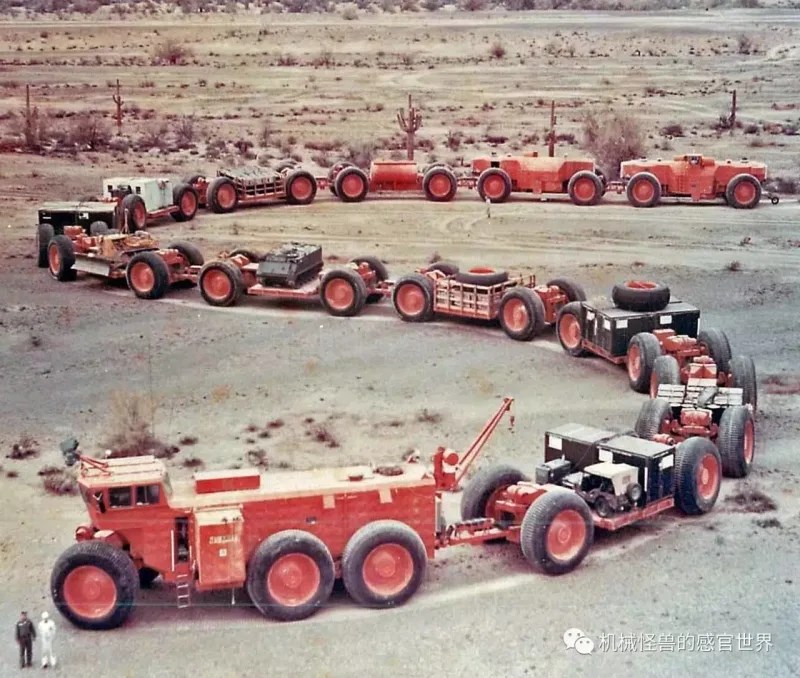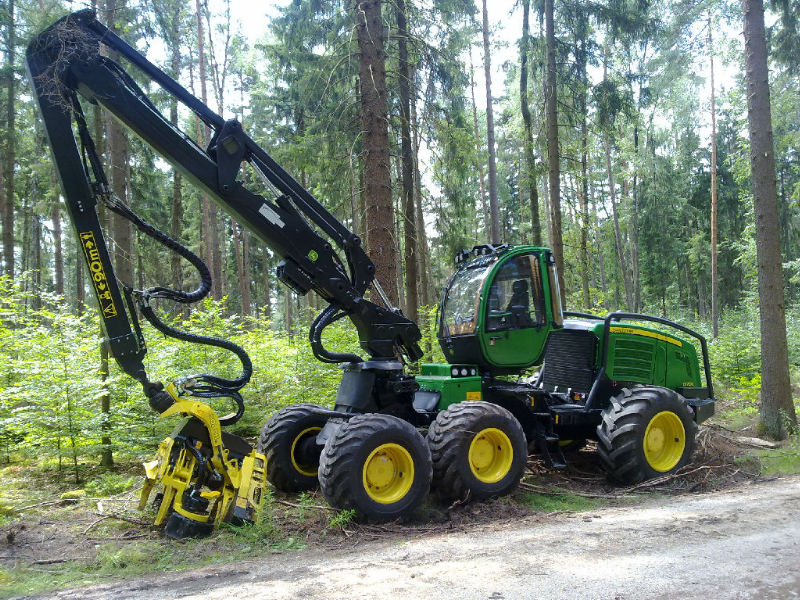TRAINS OF LAND R. G. LETOURNEAU
An article by Jean-Marc Maclou
If it is a particularly prolific inventor this is Robert Gilmour LeTourneau. He designed and built between another gigantic terrestrial trains and terrain for the cargo transportation for desert or snowy areas. If we are to believe some newspapers of the time, the ships of the desert were in tune with the times, but was he the only one to go through with his ideas by the completion of five land trains.

VC-12 Tournatrain
1 – The first was the VC-12 Tournatrain, with a power car and three trailers, 32 wheel drive with its own electric motor 140 ton payload. The Company made a demonstration on 15 Avril 1954 before US Army Tradcom of officials to convince them that these new multi-wheeled diesel-electric transmissions terrestrial trains were the best solution to transport equipment on snow. But it was never sold.
At that time, the Cold War was in full swing and the US government decided to install the DEW Line (Distant Early Warning Line), radar chain in Northern Alaska (There was 78 sites) to give warning in case of nuclear attack Soviet.

VC-22 Sno-Freighter
2 – The idea of a large carrier terrain therefore made his way and LeTourneau built in just six weeks the VC-22 Model Sno-Freighter, from 150 ton payload, five trailers and a motor lead car, all based on 24 WD. Everything was provided in the latter for the life of a crew of four men. Alfred Ghezzi, already owner of a company, l’Alaska Freight
Line Inc., consisting of a fleet of trucks, aircraft and barges acquired the Sno-Freighter to hire his services to the US Army to build the DEW Line. Al Ghezzi, great innovator throughout his life, took the bet to carry some freight by Sno-Freighter on the Tundra and mountains when soil and rivers were frozen.
Disassembled and shipped to Longview, Texas, rail, boat and road, he reached Circle City, Alaska, where it was reassembled in 5 Operating days and early April 1955. Although the monster was 'all terrain', a road, sometimes mountainous, was opened in 39 days by a fleet of 5 Caterpillar D8 bulldozers, local guides in radio contact with a company aircraft delimiting the road. Another fleet was pulling the kitchens, dormitories and repair shops. Seven other bulldozers were used to widen the road and accompany 32 Kenworth and Sno-Freighter trucks in difficult passages. The trip the Dew Line sites to the north of Alaska was about 800 km and lasted 3 per month - 50 ° C. We had to take advantage of the winter months to avoid stagnation.
The second winter, in 1955-56, the starting point was moved to Eagle and the fleet of trucks and bulldozers reinforced. Sadly, Sno-Freighter was seriously injured 60 km further. Racing down a slope, the engines worked in generators and alternators burned. The driver, inexperienced, led the train to the snow bank to try to curb the. He slowed the locomotive but trailers, unbraked, pushed the set and went on through. He became unusable and 170 t of cement were left behind. Al Ghezzi went bankrupt and his firm over by Anchorage Cold Storage and later by Sea-Land.

Side Dump Train
3 – In October 1955, LeTourneau revealed the existence of Side Dump Train 18 sidecasting wheels. Nevertheless it was not presented as a means earth because of contract 5 Wabco years with forbidding him to make earthmovers. tested up 1956, it was never sold.

Logistical Cargo Carrier
4 - In the middle of 1956, the US Army received a second train known as the Logistical Cargo Carrier, LCC-1. Composed of a lead car and three trailers 16 wheel all-wheel electrically, he had a payload 45 tonnes. Lighter, lowest trailers for stability, it was used successfully to transport equipment to replenish the DEW Line up 1961.

TC-497 Overland Train MkII
5 – Finally, the success of LCC-1 led to the construction of 5th and last earthly train R.G. LeTourneau in 1962, TC-497 Overland Model Train MkII, the most monstrous of all, discerned : This is the longest ever built vehicle 197 m, turbines over 4500 ch, 54 electromotive wheel 3.5 m, 10 trailers, 150 tons of cargo for 450 total weight ; he had studied not only for the snowy expanses but also for desert and sandy areas, all this for the price of $3.7 millions. Its autonomy was 560-640 km and its speed 32 km/h. Sent to Yuma Proving Ground, Yuma, Arizona test, it became obsolete even before commissioning. The aviation industry put into service in 1962 helicopters lifting giants, can do without roads too, but much faster. The Vietnam War absorbed the credits and it was discovered too late that several trucks are preferable to a single easily identifiable giant.
But what has become these monsters ? This is the question that every lover of beautiful machines may arise.
The first train, the Tournatrain, and the Train Side Dump certainly have been scrapped because we have heard of him. But the Sno-Freighter, his, still exists. Bought by Burgess Construction Co., the army decided in 1961 to bring him to Fairbanks to repair and continue the evaluation of land trains. In May, a team of specialists for the Alaska-Canadian Freightways reached the accident site. the LCC- 1 was the trip because its electrical circuit served, by connections, replacement of the burnt circuits of Sno-Freighter. The return lasted two months and was punctuated by delays and incidents. In 1968, Bobbie Miller bought the Sno-Freighter to $25 000 then the next purchaser, John Reeves, exposed him for tourists near Fox not far from Fairbanks Pumping Station No. 13 sur la Steese Highway.
When the LCC-1, he was removed from service after the repair operation 5 July 1961 and the lead car can be seen now in the court of Carl Pedersen on Badger Road near North Pole to posher Fairbanks trailer Cherokee Lodge in South Delta. One can always hope that it will be saved as a public is interested more and more in these huge ancient monsters who are now part of heritage. You can see the sites: http://www.letu.edu/about_LU/museum/footprints/previous_entries.htm

Et l’Overland Train MkII, you say ? He stayed at Yuma Proving Ground Heritage Center, Yuma, Arizona where the lead car (photo 6) was restored a few years ago and exposed. Sadly, trailers were scrapped in 1971. Again there is a site :








